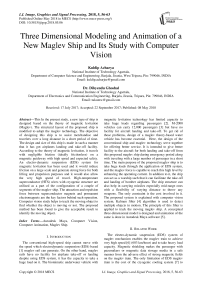Three dimensional modeling and animation of a new maglev ship and its study with computer vision
Автор: Kuldip Acharya, Dibyendu Ghoshal
Журнал: International Journal of Image, Graphics and Signal Processing @ijigsp
Статья в выпуске: 5 vol.10, 2018 года.
Бесплатный доступ
This In the present study, a new type of ship is designed based on the theory of magnetic levitation (Maglev). The structural layout of the proposed ship is modified to adopt the maglev technology. The objective of designing this ship is to assist merchandise and travelers over a long distance in a short period of time. The design and size of this ship is made in such a manner that it has got airplanes landing and take-off facility. According to the theory of magnetic levitation, it travels with negligible friction (ideally frictionless) on a magnetic guideway with high speed and expected safety. An electro-dynamic suspension (EDS) system for magnetic levitation has been used and it would reduce friction on a large scale and generate strong force for both lifting and propulsion purposes and it would also allow the very high speed of travel. High-temperature superconductor (HTS) wires with cryogenic structure are utilized as a part of the configuration of a couple of segments of the maglev ship. The attraction and repulsion force between superconductor magnets and permanent electromagnets are the key factors behind such operation. Computer vision study helps to track the moving object to find whether the object is moving or not. The proposed method has been found to give the acceptable result to identify the moving object.
Autodesk Maya, Computer Vision, Computer Animation, Maglev Ship
Короткий адрес: https://sciup.org/15015964
IDR: 15015964 | DOI: 10.5815/ijigsp.2018.05.06
Список литературы Three dimensional modeling and animation of a new maglev ship and its study with computer vision
- Marc T. Thompson; Richard D. Thornton (May 1999). "Flux-Cancelling Electrodynamic Maglev Suspension: Part II Test Results and Scaling Laws". (PDF). IEEE Transactions on Magnetics 35 (3).
- Maglev2000.com, maglev2000.com, ‘The Water Train’, [online]. http://www.maglev2000.com/apps/apps-04-b.html. [Accessed: 2016 , November].
- The graphic: maglev train [news briefing], engineering & technology, volume 10, issue 5, pp.16-16, iet journals & magazines.
- Motion-Based Multiple Object Tracking, http://in.mathworks.com/help/vision/examples/motion-based-multiple-object-tracking.html?searchHighlight=kalman%20filtering%20object%20tracking&s_tid=doc_srchtitle
- Maya, http://www.autodesk.com/education/free-software
- Type II superconductors, http://hyperphysics.phy- astr.gsu.edu/HBase/solids/scond.html#c5.
- "principle of maglev." railway technical research institute. retrieved 25 May 2012.
- h. Maeda, y. Tanaka, m. fukutumi, and t. Asano (1988). "a new high-tc oxide superconductor without a rare earth element." jpn. j. Appl. phys. 27 (2): 209–l210. bibcode:1988, jajap.27l.209m.
- The levitating superconductor, http://www.ted.com/talks/boaz_almog_levitates_a_superconductor.
- M. Ono, S. Koga and H. Ohtsuki, "Japan's superconducting Maglev train," in IEEE Instrumentation & Measurement Magazine, vol. 5, no. 1, pp. 9-15, Mar 2002. doi: 10.1109/5289.988732
- Hyung-Woo Lee, Ki-Chan Kim and Ju Lee, "Review of maglev train technologies," in IEEE Transactions on Magnetics, vol. 42, no. 7, pp. 1917-1925, July 2006.
- L. Schultz et al., "Superconductivity levitated transport system - the SupraTrans project," in IEEE Transactions on Applied Superconductivity, vol. 15, no. 2, pp. 2301-2305, June 2005. doi: 10.1109/TASC.2005.849636
- H. Maeda; Y. Tanaka; M. Fukutumi & T. Asano (1988). "A New High-Tc Oxide Superconductor without a Rare Earth Element". Jpn. J. Appl. Phys. 27 (2): L209–L210. Bibcode:1988JaJAP..27L.209M.
- Huynh-Thu, Q.Scope of validity of PSNR in image/video quality assessment, Electronics Letters, 44, 2008, pp. 800–801.


